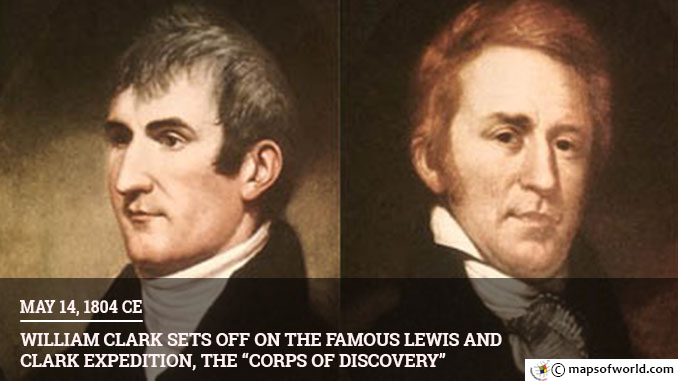The Lewis and Clark Expedition, the Corps of Discovery, was a historic expedition undertaken by Meriwether Lewis and William Clark to secure the western regions – the Northwest and Oregon regions of the Pacific coast for the United States of America. On May 14, 1804, William Clark set out from St. Louis and was soon joined by Meriwether Lewis on this memorable journey. President Thomas Jefferson commissioned this exploration as a journey to discover a transcontinental water route along the Missouri River. It was also meant to negotiate American authority over the western territory and establish US sovereignty along the route. The Corps of Discovery was the realization of President Jefferson’s vision of building a united nation that stretched all the way from the Atlantic to the Pacific shores. The US Congress approved the Lewis and Clark Expedition in 1803. The purpose of the expedition was to secure the commercial routes to the West – the Northwest Passage – before the Europeans exploited the trade potential of the region. Jefferson was aware that Europeans had set their sights on the Pacific shores and wanted to make as much headway as possible before the colonists could break ground. To understand the full potential of the Louisiana Purchase Treaty, Jefferson needed trusted and trained men to explore the topography and the bio-life of the region. The expedition would involve negotiating with the naïve Indians and creating accurate maps that could be used for times to come. It would take girth and discipline to uncover the wilderness of the unchartered west, Jefferson turned to Captain Lewis who had after his military service also served as the president’s personal secretary. Captain Lewis further suggested that his former Army colleague William Clarke co-lead the mission Meriwether Lewis was an experienced naturalist. For about a year, since the approval of the expedition by the Congress he trained in Botany, Zoology, Anthropology, Medicine, and Astronomy at the University of Pennsylvania. He studied closely the drafts of maps drawn up by trappers and traders who had made a foray into the West. Much of it was, however, unchartered territory. Nobody even knew if a water route to the Pacific was even possible. William Clarke was an excellent cartographer. He enlisted the help of renowned cartographers and navigators. Over forty other men were chosen to accompany Lewis and Clarke. Apart from these men, the leaders, Lewis and Clark also chose a fifteen-year-old Shoshone Indian woman called Sacagawea to accompany them. Shoshone was a new mother and had given birth to a child a couple of months before the party set out. Her presence made the native Indians encountered by the party amenable to negotiations. She also acted as their translator through the expedition. On May 14, 1804, William Clark set out from their St. Louis base camp, Camp Dubois. Lewis met with Clark and the men on May 20 at St. Charles in Missouri and the corps set out westward along the Missouri River. They traversed the region that would later become North Dakota. The expedition party celebrated the first Fourth of July near Atchinson in Kansas. Enroute the party met with many native Indian tribes – they negotiated with most, buying them with recognition and gifts. After having crossed the Continental Divide, the explorers came to meet Sacagawea’s tribe – the Shoshone Indians. Here they purchased horses to carry them on their journey down through the Bitterroot Mountains. The next part of the journey – the rapids of the Clearwater and Snake rivers – was undertaken in canoes. Lewis and Clark then led the team through the Columbia River to the sea. Through the early months of 1805, the party traveled across the Rocky Mountains. In about November 1805, Lewis, Clark and the expedition party reached Oregon on the Pacific Coast. Since the winter was bitter they decided to spend the winter in the Oregon camp and postpone the return journey to 1806. By September 1806, they returned to St. Louis. In all, the party had covered over 8,000 miles of what had been previously considered unpassable terrain. The Corps of Discovery was a path braking expedition in opening up the West and provided valuable information about the terrain, the plants and animals. Over 178 plants and 122 animals, hitherto unknown were discovered in the course of the expedition. Lewis and Clark maintained detailed journals about the natural environment, the native people, and their cultures. The opening up of the West also meant that the West had opened up to American settlement and that the establishment of a commercial link right through to the Pacific coast became a real possibility. It also served a scientific purpose of acquainting the Americans with the flora and fauna of the West. Through the twentieth century, the Lewis and Clark Expedition started to gain appreciation and importance. The bicentennial celebrations of the expedition involved the participation of people and groups from all over the U.S. Also on this day: 1948 – Prime Minister David Ben-Gurion proclaims the independent State of Israel. 1955 – The Warsaw Pact is signed in Poland by the Soviet Union and seven other communist bloc countries. 1964 – Egyptian President Nasser and Soviet leader Khrushchev divert the Nile. 1973 – Skylab One, the first US manned space station is launched into orbit. 1985 – The first McDonald’s restaurant in Illinois is converted into the first fast-food business museum.
May 14 1804 CE – William Clark Sets off on the Famous Lewis and Clark Expedition, the “Corps of Discovery”
The Lewis and Clark Expedition, the Corps of Discovery, was a historic expedition undertaken by Meriwether Lewis and William Clark to secure the western regions – the Northwest and Oregon…
524
